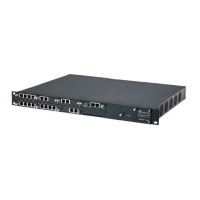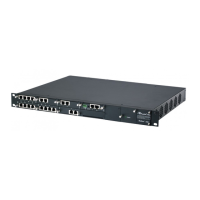Version 7.2 697 Mediant 1000B Gateway & E-SBC
User's Manual 34. Routing SBC
Routing Policy lets you configure routing rules for calls belonging to specific SRD(s).
However, as multiple Routing Policies are relevant only for multi-tenant deployments (if
needed), for most deployments, only a single Routing Policy is required. As the device
provides a default Routing Policy ("Default_SBCRoutingPolicy"), when only one Routing
Policy is required, the device automatically assigns the default Routing Policy to the routing
rule. If you are implementing LDAP-based routing (with or without Call Setup Rules) and/or
Least Cost Routing (LCR), you need to configure these settings for the Routing Policy
(regardless of the number of Routing Policies employed). For more information on Routing
Policies, see ''Configuring SBC Routing Policy Rules'' on page 715.
The IP-to-IP Routing table also provides the following features:
Alternative Routing: In addition to the alternative routing/load balancing provided by
the Proxy Set associated with the destination IP Group, the table allows the
configuration of alternative routes whereby if a route fails, the next adjacent (below)
rule in the table that is configured as 'Alt Route Ignore/Consider Inputs' are used. The
alternative routes rules can be set to enforce the input matching criteria or to ignore
any matching criteria. Alternative routing occurs upon one of the following conditions:
• A request sent by the device is responded with one of the following:
♦ SIP response code (i.e., 4xx, 5xx, and 6xx SIP responses) configured in the
Alternative Routing Reasons table (see ''Configuring SIP Response Codes
for Alternative Routing Reasons'' on page 713).
♦ SIP 408 Timeout or no response (after timeout).
• The DNS resolution includes IP addresses that the device has yet to try (for the
current call).
Messages are re-routed with the same SIP Call-ID and CSeq header fields (increased
by 1).
Note: If the Proxy Set (see Configuring Proxy Sets on page 367) associated with the
destination of the call is configured with multiple IP addresses, the device first
attempts to route the call to one of these IP addresses, starting with the first listed
address. Only when the call cannot be routed to any of the Proxy Set’s IP addresses
does the device search the IP-to-IP Routing table for an alternative routing rule for the
call.
Re-routing SIP Requests: This table enables you to configure "re-routing" rules of
requests (e.g., INVITEs) that the device sends upon receipt of SIP 3xx responses or
REFER messages. These rules are configured for destinations that do not support
receipt of 3xx or REFER and where the device handles the requests locally (instead of
forwarding the 3xx or REFER to the destination).
Load Balancing: You can implement load balancing of calls, belonging to the same
source, between a set of destination IP Groups known as an IP Group Set. The IP
Group Set can include up to five IP Groups (Server-type and/or Gateway-type only)
and the chosen IP Group depends on the configured load-balancing policy (e.g.,
Round Robin). To configure the feature, you need to first configure an IP Group Set
(see Configuring IP Group Sets on page
719), and then assign it to a routing rule with
'Destination Type' configured to IP Group Set.
Least Cost Routing (LCR): If the LCR feature is enabled, the device searches the
routing table for matching routing rules and then selects the one with the lowest call
cost. The call cost of the routing rule is done by assigning it a Cost Group. To
configure Cost Groups, see ''Least Cost Routing'' on page
267. If two routing rules
have identical costs, then the rule appearing higher up in the table (i.e., first-matched
rule) is used. If a selected route is unavailable, the device uses the next least-cost
routing rule. However, even if a matched rule is not assigned a Cost Group, the device

